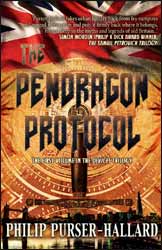|
Click here to return to the main site. Book Review
The Circle are the modern-day successors of the Knights of the Round Table. Armed with the latest military hardware and operating from a hidden fortress on the South Bank of the Thames, they protect 21st-century Britain from certain very specific threats – criminals who, like the Circle’s own Knights, have characters from Arthurian legend living inside their heads. Jory Taylor, the Knight bearing the device of Sir Gawain, has grappled on the Circle’s behalf with mercenaries, serial killers and far-right terrorist cells. However, when he is captured by Gawain’s traditional enemy the Green Knight, he discovers a new side to the myths he lives by – one which, as he learns more about this clandestine world, becomes both threateningly personal and terrifyingly political... This novel ought to appeal to anyone who has even a passing interest in Arthurian legends. I state this with confidence, as someone who has only a passing interest in Arthurian legends. I know about Arthur and Merlin, Lancelot and Guinevere (surely we all do – and I don’t just mean the National Lottery machines), but I was surprised to read that Mordred’s mother was not Morgan le Fay. After a quick bit of Googling, it turns out that in older versions of the myth she was Morgause, Morgan le Fay’s sister – thanks, Philip Purser-Hallard, I’ve learned something today! The Pendragon Protocol, the first in a trilogy of books, imagines a world in which the spiritual successors of the Knights of the Round Table remain active to this day. They carry out semi-secret defence duties, which sometimes bring them into conflict with the more conventional authorities (who are personified by the fiery-tempered Inspector Jade Kinsey). The Knights still carry steel swords, but their armour is a modern boron-carbide ceramic, their shields are toughened polyester with a riot-shield-style transparent upper portion, and their men-at-arms carry semi-automatics. Each Knight is associated with one of his legendary forbears. In the case of the main character, Jory Taylor, this is Sir Gawain. The connection is known as the device, but it is not merely a heraldic symbol. The Knight actually takes on characteristics of his predecessor – though whether this is the result of possession, spiritual faith, psychosomatic delusion or just plain madness is a question that is debated throughout the novel, allowing the reader to latch on to whichever interpretation they prefer to believe. Personally, I quite like a bit of fantasy. Like Superman, Gawain is energised by the sun, which means Jory is weaker during the night. Also in common with the Man of Steel, the Knights can be constrained by their chivalric code of conduct, which limits the level of action they can take against an enemy, depending on how well armed that enemy is. A promise made by a Knight is binding, which effectively makes Jory a prisoner for some time. A more Hulk-like quality is that Jory is also troubled by Gawain’s violent urges in the heat of battle, though it’s less a case of “Hulk smash!” than “Gawain chop!” The first two-fifths of the novel alternate between present-day present-tense scenes and flashbacks though the histories of certain characters. These dual timelines often contrast with each other in terms of action, with battle scenes in one thread ensuring that the briefing scenes of the other do not lose the reader’s interest. This is not to say that the explanatory bits are boring – for me, some of the most intriguing passages are those in which Malory, the Circle’s civilian psych profiler, discusses with Jory the intricacies of the devices. The irreverent style of the narrative voice, Dale the Tale, also helps by lightening the tone whenever the text might be in danger of becoming too sombre or nerdy. Even so, I found that the book became more engaging from two-fifths of the way in, when the ‘then’ and the ‘now’ resolve into a more linear narrative. Here things really kick off. The author manages to smuggle in another British legend in such a way that I think I registered it subliminally, while on a conscious level I was taken completely by surprise. Readers may well find themselves slapping their foreheads and uttering phrases along the lines of: “Of course! Why didn’t I realise?” To say much more than that would seriously spoil the plot for you. I could tell you, but Gawain would have to behead you. The truth will out if and when I get to review the next part of this trilogy, which is due next year, and to which I am very much looking forward. 8 Richard McGinlay Buy this item online
|
|---|


